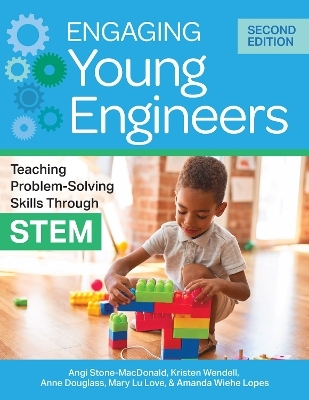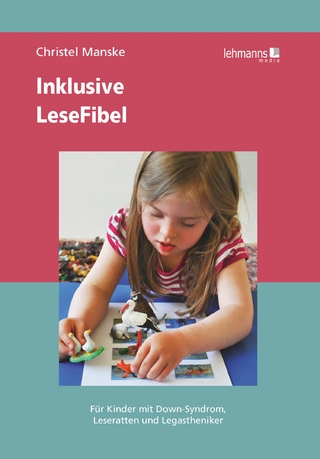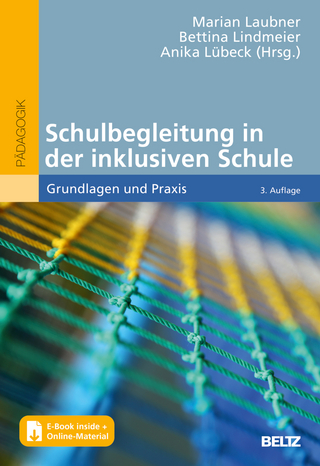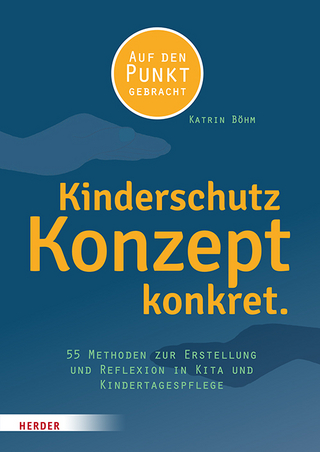
Engaging Young Engineers
Brookes Publishing Co (Verlag)
978-1-68125-749-5 (ISBN)
Boost young children’s problem-solving skills and set them up for long-term success with the second edition of this practical guidebook! Enhanced with new lessons and timely topics—including equity and the use of makerspaces—this book will help you get all children ready for kindergarten by teaching them basic practices of engineering design and critical thinking skills.
Using a clear instructional framework and fun lesson plans tailored for infants, toddlers, and preschoolers, you’ll guide your “emerging engineers” as they explore big ideas and develop new ways of thinking through engaging and challenging learning experiences. Practical materials include classroom-tested activities that incorporate children’s books, self-reflection checklists, practical strategies and modifications, Early Childhood UDL Planning Sheets, and blank Experience Planning Templates.
EDUCATORS WILL
Introduce hands-on learning experiences that teach critical thinking skills—curiosity, persistence, flexibility, reflection, and collaboration
Demystify and teach key phases of engineering design: think about it, try it, fix it, and share it
Support school readiness by helping children work toward kindergarten standards, including Common Core State Standards and Next Generation Science Standards
Use universal design for learning (UDL) principles to ensure that learning experiences work for all children, with and without disabilities
Encourage language and literacy development with suggestions for weaving reading into problem-solving experiences and using language to prompt children’s thinking skills
Promote other skills needed for school success, including social-emotional skills, self-regulation, and executive functioning
WHAT’S NEW: Three new themes: computational thinking, makerspaces, and inclusion and equity in STEM | Every lesson plan updated | More lessons based on new children’s books | New art/music/drama lesson options for STEAM-focused schools | More coverage of spatial development | Expanded information on assessment | Updated book resources and references
Angi Stone-MacDonald, Ph.D., is an Assistant Professor at the University of Massachusetts Boston in the Early Education and Care in Inclusive Settings program. Dr. Stone-MacDonald has worked with children with disabilities and their families for the last 17 years as a paraprofessional, teacher, consultant, and researcher. Her areas of research include early intervention, international special education for children with developmental disabilities, and teacher preparation for early intervention. Anne Douglass, Ph.D., is Assistant Professor of Early Childhood Education in the College of Education and Human Development at the University of Massachusetts at Boston, where she directs the Bachelor’s degree program in Early Education and Care in Inclusive Settings. Dr. Douglass’s research focuses on early childhood policy, professional development, quality improvement, and leadership. Mary Lu Love, M.S. is Lecturer/Director of Early Childhood Services at the Institute for Community Inclusion at University of Massachusetts Boston, where she manages grants, evaluation projects and variety of grant work in the early childhood field. Kristen Wendell, Ph.D., is Assistant Professor of Elementary Science Education at the University of Massachusetts Boston. Her teaching and research interests include pre-service and in-service teacher education in science and engineering and the integration of engineering design into children’s science, reading, and writing experiences.
Tentative 2nd edition Table of Contents (prior to revision)
About the Authors
Acknowledgements
A Note to the Reader
Part 1- Why Engineering and Problem Solving are Important Early Childhood Inclusive Classrooms
Chapter 1: Young children are Natural Problem Solvers
In this chapter, we would review material from Engaging Young Engineers about the importance of teaching critical thinking and problem solving and a method to do that using the engineering design process. We would review our early childhood model and talk about how you can incorporate these lessons and chapters into preschool and kindergarten classes so that they address STEM and literacy. Finally, we would review the applications of Universal Design for Learning in the problem-solving process and how these lessons are applicable to all classrooms, including those with students with disabilities and students who are emerging bilinguals.
Currently, Chapter 1 serves to (a) review key prior work to bring STEM learning to children from birth to age 5, (b) “demystify” engineering design, and (c) introduce the five thinking skills that are important to engineering design as well as to young children’s problem-solving development. We will maintain these three goals for Chapter 1, but we will update each of the three main sections.
In the “Approaches to STEM Learning” section, we will refer to more recent texts and curriculum materials including recent preschool-aimed “Wee Engineer” program by the Engineering Is Elementary group at Museum of Science Boston and the “Storybook STEM” resources by TERC and the University of Notre Dame, and Marina Bers’ “Coding as a Playground” work on computational thinking with young children. We will also acknowledge making/maker spaces as an important recent turn in STEM education more broadly.
In the “Engineering Design Demystified” section, we will update the “shopping cart challenge” example of engineering design to a more recent case with more contemporary references, and we will expand definitions of engineering and technology to incorporate humanistic aspects such as understanding societal impact, collaborating closely with communities, and using engineering in one’s own home and community. We will acknowledge that the engineering profession has a problematic history of excluding and marginalizing people of color and that the public narrative about engineering has not historically recognized all the STEM problem solving that occurs in the daily lives of people from all backgrounds, including people of color. We will articulate a goal of reversing this pattern.
In the “Our Problem Solving Framework” section, we will make updates to incorporate recent attention to computational thinking as a component of modern problem solving. We will discuss how computational thinking is used within engineering design even when computer programming is not explicitly needed. As we introduce the five thinking skills, we will mention the most relevant computational thinking practices for both engineering and young children, including decomposition (breaking apart a larger system, process, or problem into smaller, more manageable chunks) and algorithmic thinking (systematically generating a process that produces similar outcomes given similar inputs).
Chapter 2: Universal Design for Learning (UDL) in Inclusive Early Childhood Settings
While this chapter will remain largely the same, we will update the explanations to include insights from Six Steps to Inclusive Preschool Curriculum by Eva Horn et al. (2018) and Universal Design for Learning in the Early Childhood Classroom: Teaching Children of All Languages, Cultures, and Abilities, Birth-8 Years by Brillante and Nemeth (2017). We will also update the “Research Evidence…” section and add newer references throughout the chapter, as applicable. We would also consider moving the section on the profile children from “Note to Reader” in the pre-matter to this chapter and adding a few more vignettes with children from with different abilities, languages, and cultures to Chapters 3-7 after briefly adding introductions to those children here.
Part 2: Overview of the Book Format, Templates, and Tools
In this section, we will remind readers of the overall format of the remaining chapters with lessons and units and the various templates and tools available in each chapter. The lessons can still be taught as stand-alone lessons or as units. Each chapter will be aligned to a thinking kills and include two (2) lessons for each age group (previously it had one lesson). Chapters 3-7 with the lessons will follow the same format and use several different text features to support teachers in implementing the units, such as teacher annotations as reminders or thought bubbles with possible questions teachers could ask students at various moments in the lesson. We will introduce new books to use with the lesson for each age group, both fiction and non-fiction books. We will also include references to ways to include Makerspaces in these lessons and products from Makerspaces in the lessons.
In each chapter from 3-7, it will follow the same format.
Goals and Objectives of the unit
NGSS and CCSS addressed and pre-requisite skills addressed
The original set of lessons (with any needed updates)
A new set of lessons (one infant, one toddler, and one preschool) in each thinking chapter
Directions on how to apply the engineering design process concepts in lessons/unit
Literature links for fiction and non-fiction texts related to the lessons and content
UDL template for the unit
Connections to ways to incorporate
Ideas for Low cost/no cost materials to use in the unit
Chapter 3 – Curious Thinkers
Chapter 4 – Persistent Thinkers
Chapter 5 – Flexible thinkers
Chapter 6 – Reflective thinkers
Chapter 7 – Collaborative thinkers
Chapter 8: Curious, Persistent, Flexible, Reflective, and Collaborative Teachers
This chapter will be updated with a new vignette and any editorial updates that are needed. In this chapter, we will also help teachers to be more explicit in how they design their lessons for STEM and how to connect the use of Makerspace. We will look at what that means for teachers and how teachers become equipped and can experience Makerspaces themselves, as well as create them for others.
Chapter 9: Tools and Resources for Teachers (new chapter)
This chapter will provide links and suggestions for teachers who want to do more with STEM, engineering education, and problem solving in their classroom. We will offer additional tips and tricks on how to infuse STEM into your classrooms.
Appendix: Tools and Templates
Early Childhood UDL Planning Sheet-Infants
Early Childhood UDL Planning Sheet-Toddlers
Early Childhood UDL Planning Sheet-Preschool
Blank Early Childhood UDL Planning Sheet
Blank Infant Experience Planning Template
Blank Toddler Experience Planning Template
Blank Preschool Experience Planning Template
General material list; both standard materials and low cost/no cost materials
| Erscheinungsdatum | 01.02.2024 |
|---|---|
| Verlagsort | Baltimore |
| Sprache | englisch |
| Maße | 216 x 279 mm |
| Gewicht | 306 g |
| Themenwelt | Schulbuch / Wörterbuch |
| Naturwissenschaften | |
| Sozialwissenschaften ► Pädagogik ► Schulpädagogik / Grundschule | |
| Sozialwissenschaften ► Pädagogik ► Vorschulpädagogik | |
| ISBN-10 | 1-68125-749-1 / 1681257491 |
| ISBN-13 | 978-1-68125-749-5 / 9781681257495 |
| Zustand | Neuware |
| Informationen gemäß Produktsicherheitsverordnung (GPSR) | |
| Haben Sie eine Frage zum Produkt? |
aus dem Bereich


